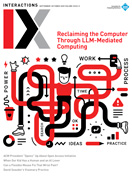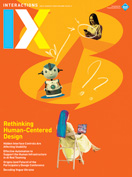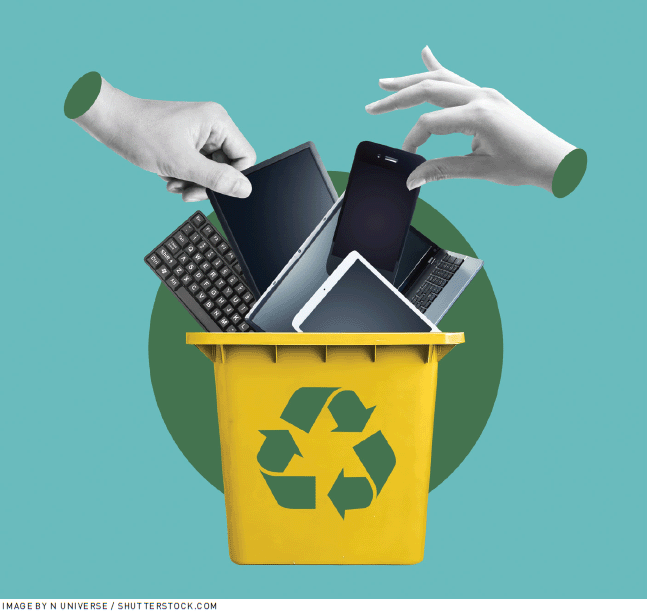Authors:
Melissa Gregg
If reusing technology is key to a more sustainable industry, where can we best learn how to design with this intention? At the recent International Association for Media and Communication Research (IAMCR) conference in Singapore, my fellow panelists Ramon Lobato, Rahul Mukherjee, Dang Nguyen, and I set out to discuss reuser experience in a range of cultural settings, including the U.S., Australia, Vietnam, and India. A roomful of scholars, journalists, and students came along to learn how the secondary market facilitates technology consumption in many areas beyond the formal settings that define product timelines.
IAMCR's strength lies in the ability to provide access to genuinely global research and scholarship. This annual academic gathering is a rare and vital platform to show how wealthy countries' assumptions about media and technology adoption play out differently in other regions. In places unaccustomed to being the first in receiving new technology, innovation abounds in ways that make reuse common, even mainstream—a stark contrast to some troubling trends in product design common in developed countries that work against sustainable stewardship. Understanding these differences was the goal of our panel.
Lobato's research in Australia on smart TVs shows that consumers are particularly devoted to regular upgrades to enjoy larger screens and sharper picture quality. This highvelocity adoption pattern is related to the size of homes in Australia, which allows for ever bigger TVs. The software-driven nature of TV consumption today makes it nearly impossible to encourage hardware reuse, since the responsibility for a product's endurance is split between the equipment manufacturer and the digital platform delivering content. This is another way that the siloed version of industrial UX fails to offer easy pathways for sustainable consumption. The software and hardware "experience" is designed separately by teams in different companies, distant from each other in time and space. The business model for high-tech manufacturing doesn't hold an incentive to build longer-lasting products, while streaming platforms care little about which hardware you use, so long as the subscription remains active. Throw in changes to spectrum standards, and you have a recipe for product obsolescence and e-waste on a large scale.
Alternatively, in places more attuned to the number of components that go into a digital device—manufacturing and assembly work so often happens in the Asia-Pacific region, after all—technology users show a range of skills and entrepreneurial techniques to wrest more life from hardware. In India, Mukherjee's research is part of a tradition of anthropological media and communication studies highlighting the practice of jugaad [1]. This term refers to so-called frugal innovation, where individuals work with and around imposed resource limits to extract value from digital remains: a microSD card can power a radio; a phone repairer can set up a loan shop. The services generated at component level can be multiplied once Western notions of ownership no longer reside with the device.
In a world of depleting resources, it is imperative that consumer goods get reincarnated to serve more than one life by default.
In Nguyen's research on mobile phone hackers, the quest to rebuild and repair phones is on constant display in online videos that share tricks and skills, much like a game streamer might broadcast to fans on Twitch. The sophistication of this informal repair audience was analyzed by other scholars who were at IAMCR. Yifan Wang and Changwen Chen, who are from China, continued their previous account of influencers performing tech repair as a kind of patriotic act in the stalls of Huaqiangbei [2].
While technology assembly often happens in one place, the various system parts are pulled from diverse geographic production worlds, each of which contains a microcosm of sophisticated activity (Patrick McGee's book Apple in China shows how this occurred in Japan, Singapore, Taiwan, and China over the past century). Our panel showed the further value chains that follow the disposal of a device by its first user. Shipped to another country, following evaluative assessments and grading for quality, phones and laptops make their way to exchange markets of many kinds, from the malls of Hong Kong and Shenzhen to the phone farms and spam factories of Vietnam and Laos. What's common in these locations is a focus on materials: What can be reused? Which parts are necessary for something to function? How can individual components give rise to fresh configurations that create revenue?
In Nguyen's work, so-called box farms of used mobile phones with nonfunctioning screens work perfectly well when combined together as domestic mini-servers used to automate various scams on social media—a fascinating example of hacking the digital empire. As she describes it: "A cracked screen becomes spare parts. A back cover becomes raw material. The logic here isn't disposal, it's extraction. Transformation. That's the attitude: Break it down, reroute its value, build something new."
Such examples of tech innovation and entrepreneurship are largely unacknowledged in the industry contexts I have worked in over the years. Major hardware companies and research labs design digital devices and product life cycles in linear language: build, buy, use, dispose. There is a finite period during which product services will be supported, after which the hardware will be deemed "End of Life." The formal system of business profit rests on the temporary marriage between software and hardware for this small window, even if the distinctions in durability are somewhat arbitrary. Lobato's research shows that every new change in screen technology or broadcast spectrum standards brings a threat to perceived quality. This is the escalating ramp of energy intensive "user experience" serving a customer that, in the Australian markets he studies, is obsessed with size and recency.
If your experience of computing has been one of serial upgrades, with little thought to the source or destination of the device, it may be hard to appreciate the breadth of opportunity that the same set of components can present to people living in different economic contexts. Taken further, an anthropological approach to design helps us see that belief systems less centered on the Western individual embrace the notion of afterlives in ways that are far more common in daily life. In Nguyen's paper, the cultural landscape of her native Vietnam is one such place that can seem haunted by ghosts [3]. The double reference here is to the spirit world that plays an active role in routine activities. It is also, given Vietnam's history, a reminder of the brutal war that caused thousands of lives to be lost in conditions of terror. These memories must be jarring against the backdrop of today's cordial economic relationships, despite the tariffs imposed by the U.S.
Within the sanctioned reuse economy, companies such as Framework have disrupted the terms, binding technology ownership to serial system acquisition. Computers are assembled from modular parts to enable longer life spans and selective upgrades. Under pressure from these market entrants, original equipment manufacturers, such as Apple, HP, Dell, and Lenovo, claim to empower users to repair, reuse, and resell digital devices in different ways. But in each case the authority granting access to reuse is the original builder or supplier. The terms of "consumption" are highly contingent on corporate power. Against this, design teams looking for inspiration might be better served by taking a more grounded, bottom-up approach: learning from cultures already advocating and enabling reuser experience as a matter of urgency and survival.
In a world of depleting resources, it is imperative that consumer goods get reincarnated to serve more than one life by default. Linking existing user practices observed in ethnographic research with policy and governance questions raised by standards, our panel on hardware afterlives showed how reuse can be productively studied from above, from below, and in the space between.
1. Rai, A.S. The affect of Jugaad: Frugal innovation and postcolonial practice in India's mobile phone ecology. Environment and Planning D: Society and Space 33, 6 (2015), 985–1002; http://bit.ly/4n0afmr
2. Wang, Y. and Chen, C. The unauthorized repair of the world. e-flux Journal, 146 (2024); http://bit.ly/3IfW8tX
3. Nguyen, D. The afterlives of smartphones: Phone farms in Southeast Asia. Paper presented at IAMCR Singapore 2025.
Melissa Gregg is a writer, ethnographer, and sustainability strategist to the tech industry, as well as a professor of digital futures at the University of Bristol. [email protected]
Copyright 2025 held by owner/author
The Digital Library is published by the Association for Computing Machinery. Copyright © 2025 ACM, Inc.









Post Comment
No Comments Found